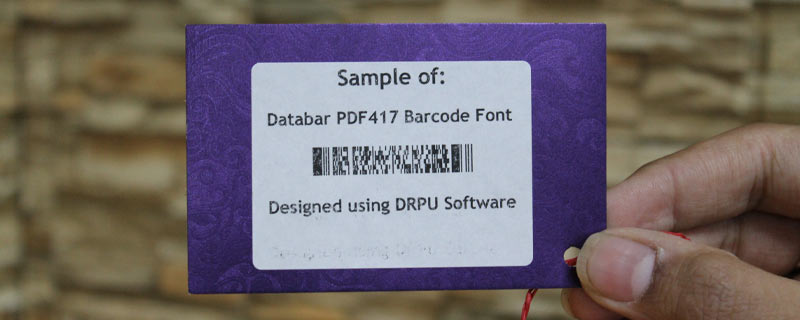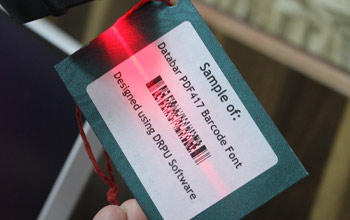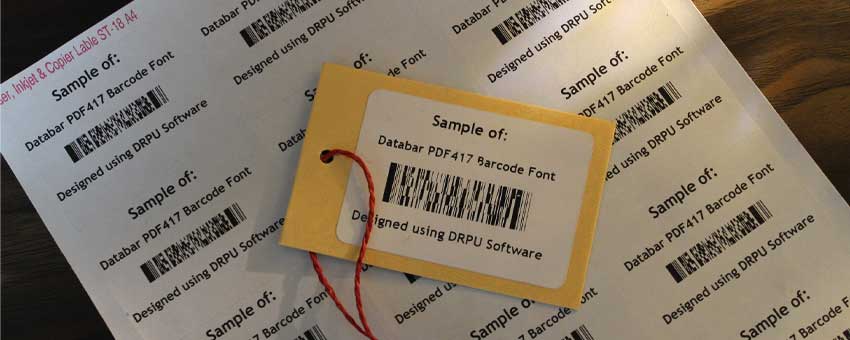Verification of Data Stored in a Databar PDF417 Barcode
A Databar PDF417 barcode is a two-dimensional barcode that can store large amounts of data in a small space. It is commonly used in applications such as transportation, inventory management, and electronic tickets. When scanning a Databar PDF417 barcode, it is important to verify the data stored in it to ensure that the information is accurate and complete. In this article, we will discuss how to verify the data stored in a Databar PDF417 barcode.

-
Understanding the Structure of a Databar PDF417 Barcode
Before verifying the data stored in a Databar PDF417 barcode, it is important to understand its structure. A Databar PDF417 barcode consists of rows and columns of dark and light modules that encode the data. Each module represents a binary digit, and the barcode reader interprets the pattern of dark and light modules to determine the data stored in the barcode.
The structure of a Databar PDF417 barcode includes three main components: the start pattern, the data codewords, and the stop pattern. The start pattern indicates the beginning of the barcode and consists of two rows of alternating dark and light modules. The data codewords are the encoded data and can be divided into segments, each of which contains a specific type of information such as the product code, quantity, and price. The stop pattern indicates the end of the barcode and consists of three dark modules.
-
Verify the Data Format
The first step in verifying the data stored in a Databar PDF417 barcode is to ensure that the data is in the correct format. This means checking that the data is encoded using the correct encoding scheme and that it conforms to the format specified by the application.
For example, if the barcode is used to store product information, the data should be encoded using the correct product code format and should include the required information such as the product name, description, and price. If the data is not in the correct format, the barcode reader may not be able to interpret the data correctly.
-
Verify the Data Content
Once the data format has been verified, the next step is to check the data content. This involves comparing the data stored in the barcode with the expected data to ensure that it is accurate and complete.
One way to verify the data content is to scan the barcode and compare the data displayed on the screen with the expected data. If there are any discrepancies, the barcode may have been encoded incorrectly or there may be errors in the data source.
Another way to verify the data content is to use a checksum or error detection code. A checksum is a mathematical algorithm that calculates a value based on the data stored in the barcode. The barcode reader can then compare the calculated value with the value stored in the barcode to detect any errors. If the values do not match, it indicates that there are errors in the data and the barcode may need to be rescanned or corrected.
-
Verify the Barcode Quality
In addition to verifying the data, it is also important to check the quality of the barcode itself. This involves checking that the barcode is printed correctly and that it can be read by the barcode reader.
One way to check the barcode quality is to use a barcode verifier. A barcode verifier is a device that checks the print quality of the barcode and provides a grade based on various parameters such as contrast, bar width, and edge sharpness. If the barcode does not meet the required grade, it may not be readable by the barcode reader.
Another way to check the barcode quality is to test it under different lighting conditions and angles. This can help to identify any issues with glare, reflections, or shadows that may affect the readability of the barcode.
Download and Install Barcode Software
Usage of Databar PDF417 Barcodes for Security or Authentication Purposes
Databar PDF417 barcodes can be used for security and authentication purposes, but their effectiveness depends on the specific application and the measures put in place to ensure the integrity of the barcode data. In this article, we will explore the features and potential applications of Databar PDF417 barcodes for security and authentication purposes.

Databar PDF417 barcodes are two-dimensional barcodes that can store a large amount of data, including text, numbers, and binary data. They can encode up to 1,850 alphanumeric characters, making them suitable for storing complex data such as shipping or inventory information. Databar PDF417 barcodes can be read by a wide range of barcode scanners and software, making them a versatile option for many applications.
In addition, Databar PDF417 barcodes can be encrypted and digitally signed, which can enhance their security and authentication capabilities. Encryption can protect the barcode data from unauthorized access and modification, while digital signatures can verify the authenticity and integrity of the barcode data.
Databar PDF417 barcodes can be used for a wide range of security applications, such as access control, asset tracking, and product authentication. Here are some examples:
-
Access Control
Databar PDF417 barcodes can be used to control access to secure areas or systems. For example, an employee's ID card can be encoded with a Databar PDF417 barcode that contains their name, job title, and access privileges. When the employee swipes their card at a card reader, the barcode data is transmitted to a central database to verify the employee's identity and access privileges.
-
Asset Tracking
Databar PDF417 barcodes can be used to track the location and status of assets such as equipment, vehicles, and documents. For example, a barcode can be printed on each asset and scanned at various checkpoints to record the asset's location and status. The barcode data can be stored in a central database and used to generate reports and alerts.
-
Product Authentication
Databar PDF417 barcodes can be used to authenticate products and prevent counterfeiting. For example, a barcode can be printed on a product label that contains the product's serial number, manufacturing date, and other information. When the product is sold, the barcode data can be scanned and verified against a central database to ensure that the product is authentic and has not been tampered with.
Databar PDF417 barcodes can also be used for authentication purposes, such as verifying the identity of individuals or the authenticity of documents. Here are some examples:
-
Identity Verification
Databar PDF417 barcodes can be used to verify the identity of individuals in various applications, such as banking, healthcare, and law enforcement. For example, a driver's license or passport can be encoded with a Databar PDF417 barcode that contains the individual's name, address, photo, and other information. When the individual presents their ID, the barcode data can be scanned and verified against a central database to ensure that the individual is who they claim to be.
-
Document Authentication
Databar PDF417 barcodes can be used to authenticate documents such as certificates, diplomas, and legal contracts. For example, a barcode can be printed on a document that contains a unique identifier and a digital signature. When the document is presented, the barcode data can be scanned and verified against a central database to ensure that the document is authentic and has not been tampered with.
In conclusion, Databar PDF417 barcodes can be used for security and authentication purposes, but their effectiveness depends on the specific application and the measures put in place to ensure the integrity of the barcode data.
Print Databar PDF417 Barcodes in Different Colors or on Different Backgrounds
Databar PDF417 barcodes can be printed in different colors and on different backgrounds, but there are some considerations to keep in mind when doing so. In this article, we will explore the factors that affect the readability and accuracy of Databar PDF417 barcodes when printed in different colors or on different backgrounds.

Databar PDF417 barcodes are two-dimensional barcodes that can store a large amount of data, including text, numbers, and binary data. They consist of a matrix of square modules arranged in a rectangular shape, with dark and light modules representing the encoded data. Databar PDF417 barcodes can be read by a wide range of barcode scanners and software, making them a versatile option for many applications.
The readability of a Databar PDF417 barcode depends on several factors, including the quality of the printing, the resolution of the scanner, and the contrast between the barcode and the background. When printing Databar PDF417 barcodes in different colors or on different backgrounds, the following factors should be considered to ensure optimal readability:
-
Contrast
The contrast between the barcode and the background is one of the most important factors affecting barcode readability. The barcode should be printed in a color that provides sufficient contrast with the background to ensure that the barcode can be easily read by a scanner. A high contrast ratio between the dark and light modules of the barcode is also important to ensure that the scanner can distinguish between them.
-
Color
Databar PDF417 barcodes can be printed in different colors, but it is important to choose a color that provides sufficient contrast with the background. Dark colors such as black, dark blue, and dark green are commonly used for printing barcodes because they provide high contrast. Lighter colors such as yellow, pink, and light blue can also be used, but they may require a higher contrast ratio to ensure optimal readability.
-
Background
The color and texture of the background can also affect the readability of Databar PDF417 barcodes. The background should be uniform and free from patterns that may interfere with the scanning process. When printing barcodes on a colored background, it is important to choose a background color that provides sufficient contrast with the barcode color to ensure optimal readability.
-
Printing Quality
The quality of the printing is another important factor affecting barcode readability. The barcode should be printed with high resolution and sharp edges to ensure that the scanner can distinguish between the dark and light modules of the barcode. Poor printing quality can result in smudging or blurring of the barcode, which can make it difficult or impossible to read by the scanner.
-
Scanner Quality
The quality of the scanner is also important to ensure optimal barcode readability. Low-resolution scanners or scanners with poor contrast detection may have difficulty reading barcodes that are printed in low contrast or on backgrounds that provide insufficient contrast.
To ensure optimal readability of Databar PDF417 barcodes when printed in different colors or on different backgrounds, the following best practices should be followed:
-
Choose a barcode color that provides sufficient contrast with the background.
-
Choose a background color that provides sufficient contrast with the barcode color.
-
Ensure that the background is uniform and free from patterns or textures that may interfere with the barcode scanning process.
-
Print the barcode with high resolution and sharp edges to ensure optimal contrast and readability.
-
Use a high-quality barcode scanner with sufficient resolution and contrast detection to ensure accurate scanning of the barcode.
In conclusion, Databar PDF417 barcodes can be printed in different colors and on different backgrounds, but it is important to consider the factors that affect barcode readability when doing so.